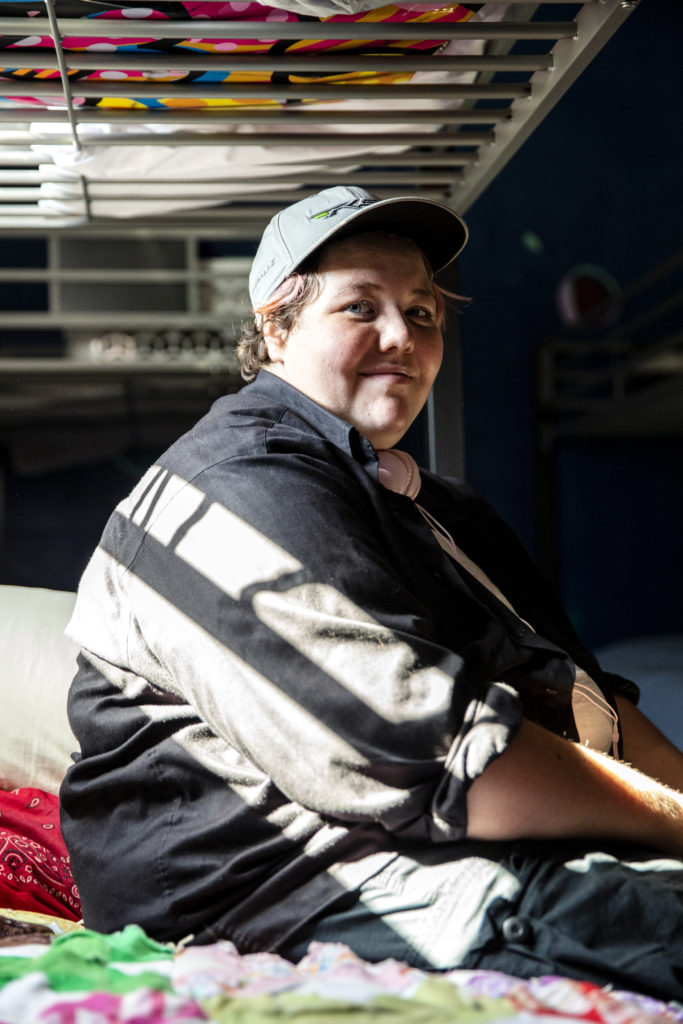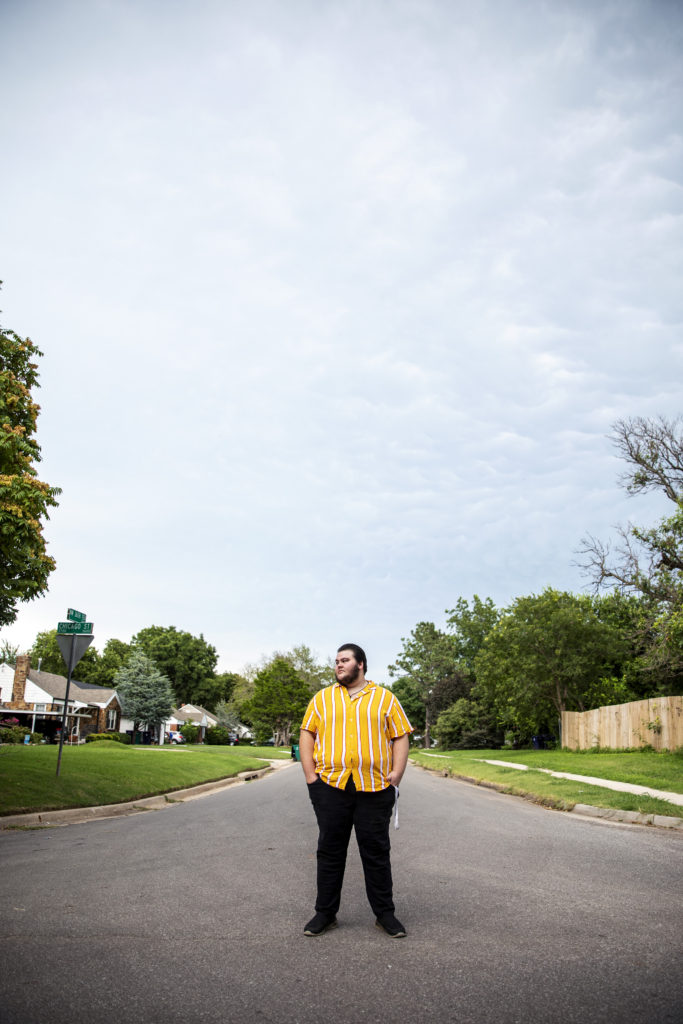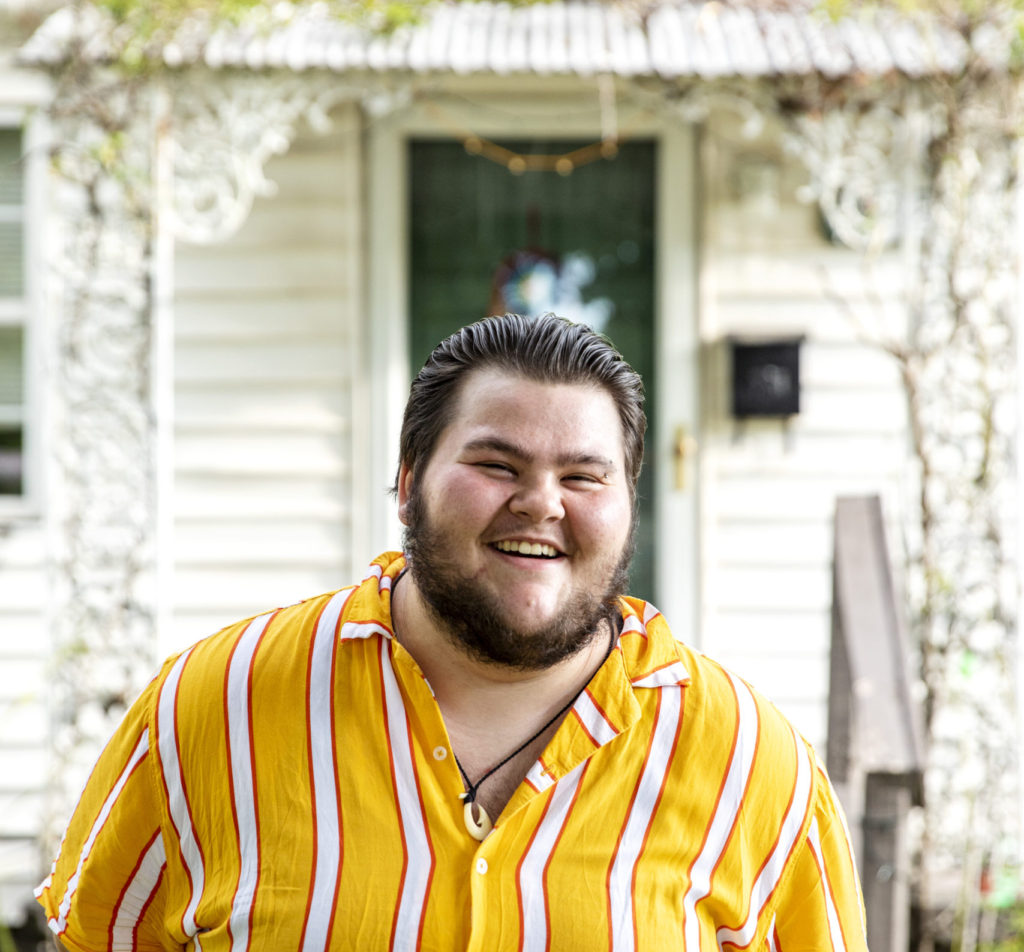Story by Haley Humphrey for Big If True and Nathan Poppe of Curbside Chronicle
Carter Bacher knows what it’s like to run out of options. He lost his mother to suicide when he was young, and he’s estranged from his father, who is serving time in prison. Family hasn’t always had his back and – like many LGBTQ+ youth – Bacher, a transgender man, faced intolerance. Bacher entered foster care when he was 16, and when he aged out of the system at 18, he slipped into homelessness.
“I had basically given up,” he said. “I thought (homelessness) was where my life was going, and this was it. I’m done. … I had no hope.”
But thanks to a growing number of resources in Oklahoma City for homeless youth – those 24 years old or younger – Bacher, now 20, has a job, lives in his own home and hopes to attend college one day.
According to this year’s point-in-time Count, an annual census of Oklahoma City’s homeless population, 90 of those surveyed were unaccompanied youth, five more than last year. However, homeless youth are notoriously undercounted. Jerod Shadid, program planner for Oklahoma City’s homeless services, said that’s because most are couch homeless, meaning they temporarily stay with a friend, relative or acquaintance.
“So many people don’t know this demographic exists,” said Jennifer Goodrich, president and CEO of Pivot, which provides shelter and other services to homeless youth.
Although shelters can serve those 18 and up, most young adults prefer to receive services from organizations that focus on their age group. Sisu Youth Services board president Heather Johnson said it can be risky to send youth to a homeless shelter with no age limit.
“Can you imagine walking into a room where 100 people have to sleep together, and the average age is 45?” Johnson said.
Shelters try to avoid housing adults and minors together, and previous point-in-time studies found that shelters with beds dedicated to youth were often at or over capacity. Last year, Oklahoma City’s homeless census reported Be The Change, a shelter for youth that has since closed, was near capacity and Sisu was over capacity. This year, Pivot and Sisu were at max capacity, according to the study from January.
“I think a lack of shelter beds is a problem for all populations, but particularly with youth who may be easier to take advantage of because of their age,” said Meghan Mueller, Homeless Alliance’s director of community capacity building. “We know that our youth are sometimes more vulnerable and susceptible to exploitation.”
In recent years, local service organizations have opened several youth-only shelters to address this issue.
Two years ago, Sisu created an emergency overnight shelter for 15 to 22-year-olds, and about four months ago, Pivot opened a shelter for 16 to 24-year-olds called The Point.

A good day no matter what
Ryan McCune, 19, and Jayden Hines, 18, both arrived at Pivot’s youth shelter in mid-August. They’re not related, but they share a lot in common. Both have family in Oklahoma, but those relationships are fractured. They’re on their own most nights to secure a meal and shelter.
The Point at Pivot has become an essential part of their daily lives, helping them obtain things like food stamps and fresh clothes.
“It’s a safe haven for me,” McCune said. “Pivot is a place to go when I have nowhere else to go. I know I can come here.”
Hines is used to having just himself to rely on, which gets exhausting. He’s found comfort at The Point largely because he trusts that the staff has his back. He starts most days with a shower and words of affirmation: Today’s going to be a good day no matter what.
“I’m here because I’m tired of being on the streets,” he said. “If I didn’t have this place, I would still be out there.”

Both McCune and Hines also have access to group or individual therapy sessions, a stocked kitchen and clean beds. Up to 11 young adults and teenagers can stay at the Point each night with social distancing guidelines in place.
“All of their stories are different. Some have (experienced couch homelessness), but for the most part, they have lived some level of street homelessness,” Goodrich said.
For McCune, the unknown is the scariest part of experiencing homelessness — not knowing who to trust can be terrifying. At The Point, McCune can unwind and listen to music on their pink headphones.
The Point aims to set a foundation of stability on every level – physically, mentally and emotionally – so that its clients are prepared to live independently after they leave.
Staff review their clients’ resumes and job applications and help them obtain social security cards and other identification so they can get on a path toward getting a job. Group discussions also play a big role in residents’ routines.
Therapist Paige Dew leads two group discussion sessions at Pivot. A variety of groups meet throughout the week and offer information on anything from education and employment to health and wellness. One goal is to teach coping skills.
“With both of those psycho-educational groups, … what we’re doing is looking at how our thoughts interact with our feelings and how those interact with our behaviors,” she said. “So, figuring out those pieces and laying it out for them in a way that teachers may not have had the opportunity to instill or parents often don’t have the skills to do.”
Homeless youth often deal with or have a history of physical and mental trauma.
“We need to work with the youth to help them overcome that trauma and help them learn that they don’t have to repeat what they went through,” Johnson said. “They’re not defined by their trauma. We’re here to help them work through things, heal and move forward.”
Before covid-19, Sisu’s shelter had bunk space for 20 youth, but four beds were lost to make space for a quarantine room.
For the first half of the year, Sisu provided services to 164 youth.
Nonprofit service provider City Care also aims to provide support and resources to homeless youth.
City Care is devoting $2.5 million to open a low-barrier night shelter, which doesn’t require clients to enter a service program, commit to being sober or provide a state ID. Parameters like this can be helpful to immediately get people off the streets, especially for those who face barriers to shelter due to mental health or addiction.
The main goal of this low-barrier night shelter, which was built to accommodate 140 people and their pets, is to get people off the streets quickly. The shelter, expected to open by the end of the year, will have four suites available to youth and families.
“The end goal we have for each of our guests is that they feel known and championed as they step through what may be the darkest season of their lives,” said Rachel Freeman, chief operating officer for City Care.
Because of the CARES Act, the City received an additional $1.4 million from the Department of Housing and Urban Development (HUD) for eviction prevention. HUD also will give the City several million more to reduce high concentrations of people at shelters and move people toward permanent housing.
But Shadid argues more resources should be available for homeless youth.
“That’s not really something that’s well within our hands. It’s a policy issue that’s sort of at the top down,” Shadid said. “That’s got to change.”
Aging out
Many providers said most youth become homeless because they have aged out of the foster care system, have been disowned by their families because they identified as LGBTQ+ or have experienced domestic violence.
“A lot of homeless youth aren’t homeless by choice, and if they are, they think that’s the only choice,” Bacher said.
According to 2019 data in Oklahoma City’s homeless database, 58% of homeless youth report being in an unhealthy or abusive relationship.
“The causes are, by and large, children aging out of the foster care system because if you don’t have margin or support, that’s when you run out of options and become homeless, and children who are LGBTQ+, who have been pushed out or rejected by their families,” Freeman said.
Shadid said there needs to be better coordination upon youth aging out of the Oklahoma Department of Human Services (DHS) and no longer receiving services.
“If there’s not someone there that can walk them through (what to do after aging out of DHS) and lead them to where they need to be, which is a place with a roof over their head and where they’re stable, youth homelessness is inevitable,” Shadid said.
Another factor that contributes to youth homelessness is cost of living. In Oklahoma City, the most expensive metro area to live in the state, renters make up more than a third of households, according to the National Low Income Housing Coalition.
The hourly wage necessary to afford a two-bedroom living space in Oklahoma City is $17.42, or a $36,240 annual income, according to an analysis from the housing coalition.
That means a person earning Oklahoma City’s minimum wage of $7.25 an hour could work two full-time jobs and still fall short. Many youth start out in low-wage, entry-level positions at work, making it hard for them to earn enough to afford living costs on their own.
“Low wages and high rental prices leave many families vulnerable to housing instability, requiring way more than the recommended 30% of their income be dedicated to housing,” Freeman said. “If you are already contributing 50% or more of your income to housing, how do you afford reliable transportation, so that you can get to your low wage-earning job, put some food on the table and pray no one has a medical emergency? Often, the two ends do not meet, and the impact can be devastating.”
The combination of the support of an advocate, shelter, food and safety makes the process of getting housing easier, Freeman said.
“Shelters save lives. There is no doubt about that,” Freeman said. “But they don’t decrease homelessness. Homes do that.”
There is a shortage of available and affordable rental homes in Oklahoma for low-income households with incomes at or below 30% of their area median income, according to the National Low Income Housing Coalition.
The coalition’s analysis determined the state needs more than 72,000 affordable rental homes to meet the housing needs of extremely low-income households.
A set-up for success
For young adults experiencing homelessness, picking up life skills and adjusting to being independent comes with its own challenges. Johnson wants to see more transitional housing, where youth can learn daily life skills, such as budgeting and cleaning.
“I can’t tell you how many kids come (into Sisu), and they don’t know how to mop, wash dishes or do laundry, and now I’m going to put you up in an apartment by yourself and say, ‘Succeed, buddy,’” Johnson said. “That’s setting somebody up to fail.”
Sisu aims to teach youth life skills, like budgeting and maintaining healthy habits, as well as soft skills. Sisu executive director Jamie Caves said the organization is preparing to expand their services to young people experiencing homelessness.
“We are working to purchase property allowing us to provide a central location dedicated to meeting basic needs and overcoming barriers alongside youth,” she said. “The services provided will include embedded mental and physical health care providers, educational classes, job readiness training, housing assistance and case management.”

In Pivot’s tiny home program, young adults transition into routines like paying rent to learn how to be self-sufficient.
Pivot’s three tiny homes are furnished, 280 to 320 square feet spaces and include a bed, bathroom, closet, kitchen and dining room table. Goodrich estimated three more units will be completed before the end of the year and 20 additional tiny homes are on track for construction throughout 2021.
After becoming the first resident in Pivot’s tiny home program, Bacher’s newfound stability helped him focus on school, where he became senior class president.
“I’ve never been good at school, but I wanted to try because I could,” Bacher said. “No matter what happens, I know Pivot has my back.”
Haley Humphrey is the news editor of Mustang News and a staff writer for the Yukon Review. Contact her at hhumphrey@theyukonreview.com and follow her on Twitter.
Nathan Poppe is editor of Curbside Chronicle. Contact him at npoppe@homelessalliance.org and follow him on Twitter.
Editor’s note: This article is part of a collaborative project on homelessness in Oklahoma City from Curbside Chronicle, Oklahoma Gazette and Big If True. This project is funded through a grant by the Inasmuch Foundation and the Ethics & Excellence in Journalism Foundation and facilitated by the Center for Cooperative Media at Montclair State University.

